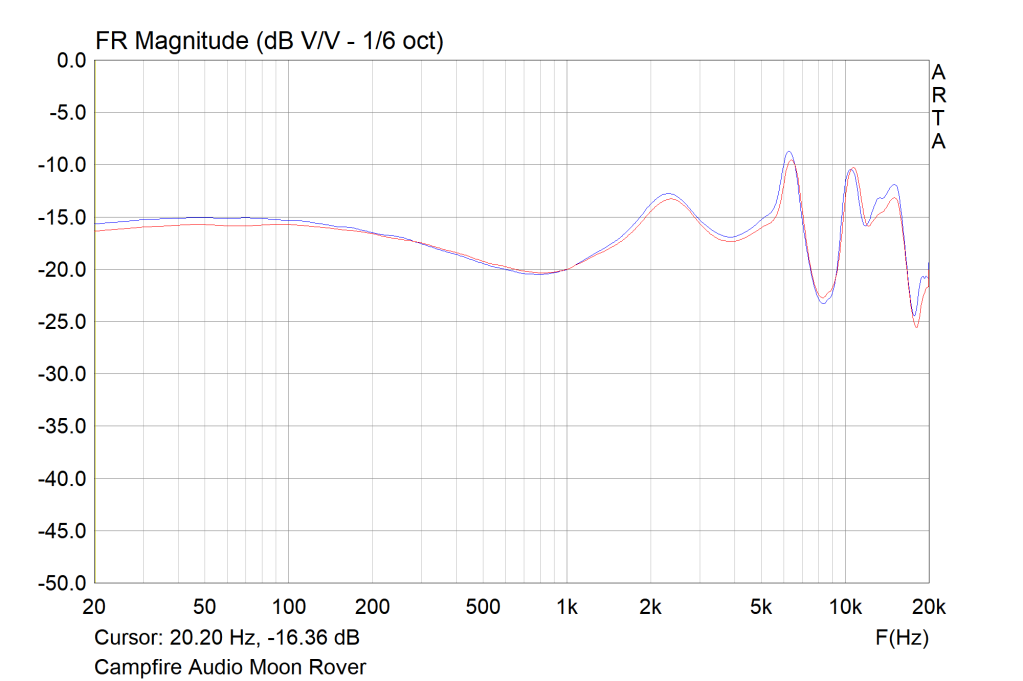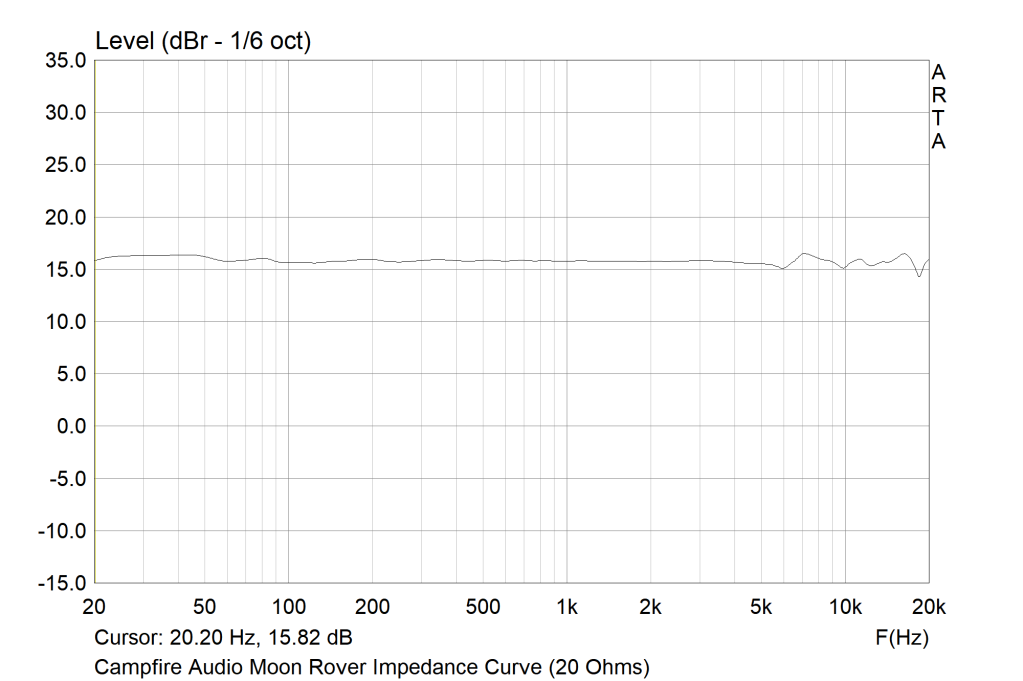Campfire Audio Moon Rover Review – Interstellar

Sound –

Testing Methodology: Measured using Arta via IEC 711 coupler to Startech external sound card. 7-9KHz peaks may be artifacts/emphasized due to my measurement setup which I found to be the case here. Measurements besides channel balance are volume-matched at 1KHz. Fit depth normalized to my best abilities to reduce coupler resonance. Still, due to these factors, my measurements may not accurately reflect the earphones or measurements taken by others.
Tonality –
The Moon Rover is a very interesting IEM that indeed lives up to its reference promise in many regards whilst introducing some spice for musical engagement. Chiefly, the bass and midrange represent good balance underpinned by a lower contrast tuning. This imbues a light warmth and increased density giving this range a coherent, full-bodied and slightly laid-back voicing overall. By contrast, the top-end is bright, energetic, and crisp with dual emphasis running through the lower and upper treble with a dip in between. The planar driver platform takes the edge off relative to BA monitors with a similar tuning and the reserved mid treble doesn’t mire with brightness and intensity. The combination of coherence and crispness forms an intriguing listening experience that is engaging whilst avoiding excessive intensity. Altogether, the Moon Rover feels equal parts the balanced monitor many wanted from the brand and traditional colourful CFA tuning.
Bass –
The bass is modestly enhanced with relatively even mid and sub bass elevation giving it a hint of extra warmth and body. Relative to Harman-target IEMs you could describe the Moon Rover as warm as the shelf extends further into the mid and upper bass. However, altogether the tuning is not that far off DF neutral IEMs like the Moondrop Blessing 2 and comes across as balanced enough for versatility and bassy enough to appeal to a wide range of listeners. It won’t appeal to those wanting an especially prominent low end nor the most weighted slam at the very bottom. While it boasts a strong extension and good drive, it lacks the gravitas of a sub-bassy DD earphone. Bass is, otherwise, very well separated, and devoid of bloat and bloom due to its well-balanced nature.
Planar magnetic drivers may not be known for their bass reproduction but the quality here is something to commend. To reiterate, the Moon Rover doesn’t provide the heartiest slam and note attack, but it is incredibly agile, tight, and responsive. The mid-bass texturing is excellent, perhaps decaying slightly too quickly to be perfectly natural but drawing out the fine details extremely well. Complex passages are rendered with surgical precision and excellent separation is always maintained. The Moon Rover won’t suit genres that benefit from great dynamics but is a detail master with a flexible tuning that is balanced yet not too conservative that it alienates.
Mids –
If there’s one area people criticize Campfire Audio, it’s likely the midrange. The Moon Rover doesn’t have a perfect timbre but it’s easily the company’s most even-handed model in terms of raw tuning. This is showcased in the form of a smooth rise to a 2.5kHz hump before a small drip through the upper midrange. I will note that the earlier peak gives it a slightly nasal voicing and as it is smaller in magnitude, the earphones slightly lean on the laid back and coherent side. Paired with a crisp lower-treble, the earphones are incredibly articulate but thankfully, not to the extent that sibilance becomes problematic. The voicing is a little breathy as a result, but the added density and low contrast nature mean the midrange doesn’t come across as diffuse either.

On the flipside, the lower-treble tuning does wonders to redeem definition and fine detail retrieval which helps to cut through the coherent mix. The Moon Rover is an interesting case as it has relatively low upper midrange clarity but also a mostly clean, neutral tone. Accordingly, it is still quite clearly expressed despite its density. Male vocals sound impressively defined and resolving while female vocals sound a little damped and full-bodied. I never found the Moon Rover veiled but it is a poor choice if you value clarity and extension due to the upper-midrange tuning. Overall, the Moon Rover is inoffensive yet highly resolving. Its tuning isn’t perfect, but it is more even-handed than the majority of competing planar magnetic earphones and Campfire’s own models too.
Highs –
In typical CFA fashion, treble is energetic, and vibrant and offers spectacular technical ability. This frequency range deviates furthest from its otherwise balanced character and, therefore, won’t be for all. Perhaps owing to the shallow insertion depth on my measurement rig, I was surprised to see just how emphasized the treble is on the frequency response graph. It doesn’t come across as nearly so overbearing in subjective listening but is still undoubtedly an energetic IEM. The lower treble sports a relatively large peak followed by a sharp 8kHz nadir and a subsequent shelf through the upper treble. I do think the note presentation contributes to my impression as, like the bass, I don’t find this driver to bite and attack like other driver types. The planar driver is immensely quick but also smooth in its note presentation.
As such, treble doesn’t stand out as the most incisive but is still crisp which is reminiscent of the note presentation seen on EST-based IEMs. The Moon Rover isn’t especially airy due to the mid-treble dip, but it does present background and fine details with exceptional clarity and presence. The boosted and brilliantly extended upper treble gives the earphone awesome headroom and micro detail in the absence of huge audible brightness. This tuning does produce quite a thin, dainty note presentation meaning purists will want to look elsewhere. Notes are delicate and lack some texture and body relative to more linear earphones. In return, the Moon Rover presents excellent sound staging and overall resolution operates at a very high level. This is a high-end IEM through and through, and it makes sure this is apparent from the first listen.
Soundstage –
The first thing that stands out about the stage is its dimensions. When the track calls for it, the Moon Rover stretches wide and deep well beyond your typical IEM. The downside is imaging which does suffer from the uneven treble tuning. The background is overly dark and therefore, the stage trails off into a black ether rather than separating into defined layers. There is a defined foreground and a jet-black background beyond but not a heap of nuance between. Directional cues remain tack sharp as does the centre image for vocals. Separation is excellent owing both to the balanced tuning and agile note presentation. The Moon Rover sounds defined, and small details are easy to discern. No frequency range overwhelms its neighbors with exception of the mid-treble due to its darkness.
Drivability –
With an impedance of 22.5 ohms and a 94dB sensitivity, the Moon Rover is slightly below average in terms of overall efficiency but not to the extent that a dedicated amplifier becomes a necessity. It’s a single driver design also so overall, should be easy to drive.
Output Impedance Sensitivity
Given its planar driver type and single driver count, I’d expect a linear impedance curve and this is what I measured in testing. The Moon Rover has a flat impedance curve meaning it will provide a similar frequency response from most sources given that the source output itself is linear.

Driving Power
The Moon Rover needs a bit of voltage to reach high listening volumes due to its below-average sensitivity. Besides volume not being as high, it is not at all demanding of the source. Comparing my THX 789 desktop stack to a portable source such as the DITA Navigator revealed minimal change in tonality or even dynamics. The desktop source was more detailed and extended in the treble but besides this, there was minimal change. The upside to this is that the Moon Rover is very resistant to source noise.
Suggested Pair Ups
The Moon Rover is very source flexible being neither constrained by driving power nor output impedance. It doesn’t pick up hiss easily and also has a balanced tonality that doesn’t push the comfort zone in any regard. I most enjoyed the Moon Rover from defined and neutral sources like the THX-based amplifiers but it can easily tolerate more warmth if you prefer a bassier sound and similarly, brightness as the tuning tones down mid-treble glare, making it forgiving in this regard. The Moon Rover is a good choice if you want quality sound without having to invest dearly in a high-end source.


I have had a pair of these for 1-2 weeks, and I have to say mine look nothing like the pictures I have seen online, both from CA themselves, and review sites like yours. While my opinions on their sound are congruent with yours, (and thankfully that is what is most important to me), anyone looking for the “flame” treatment to look like your pics or CAs, might be disappointed because mine show little to none of that effect, in fact they look close to indistinguishable from their mid-range Holocene in color. I can’t help but think that CA has cherry-picked units used for their pictures and sent to reviewers in order to maximize this visual effect. Unless I just got unlucky (or lucky depending on preference), the pics are definitely not representative of what I received for my $1200. But if you like brown, you are in like Flynn.
LikeLike
Glad you found the review was accurate,
This is a good point to note. The burnt titanium effect is more evident under strong lighting. From a photography POV, I enjoy drawing out the best angles and qualities possible out of the subject with minimal editing and use a high powered light source. I find this does tend to draw the iridescent qualities of the IEMs out more than normal lighting conditions.
With that said, even my review unit looks a lot more low key than the shots on Campfire’s website – I was expecting a bit more colour also. I still think it’s a great looking IEM and I’m glad in a way as the design isn’t loud and attention grabbing during listening in public places. I find the subtle on/off nature of the colour is tasteful and interesting.
Warm regards,
Ryan.
LikeLike